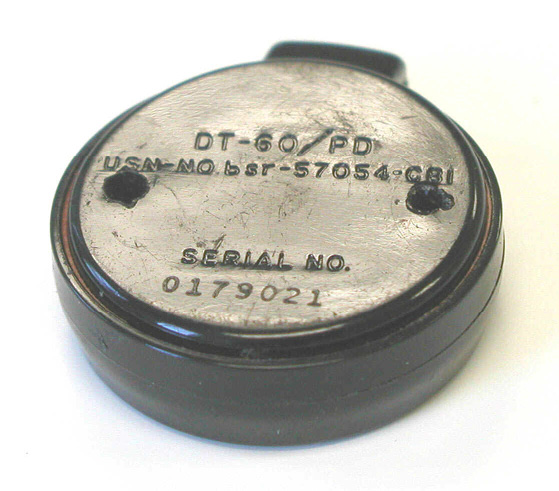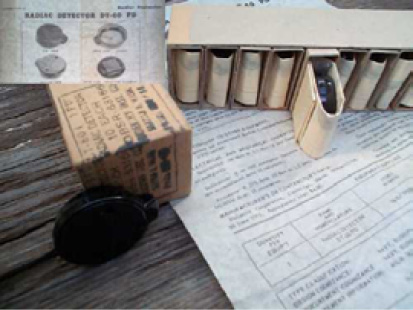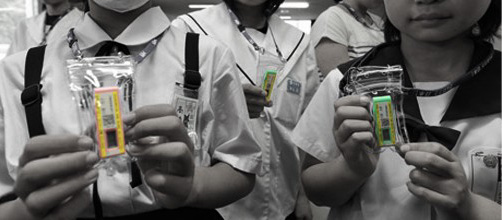30
Black-Boxing Knowledge: Glass Dosimeters and Governmental Control
Maria Rentetzi

Fig. 30.1 The photograph shows an open glass DT-60 personnel dosimeter used in the 1950s and 1960s. It was placed in a circular plastic container that opened only with a special tool to protect sensitive radiation data (source: ORAU, Health Physics Historical Instrumentation Museum Collection)
Material: plastic case that opens only with a special tool; the sensitive material is encased within, in a single ½ inch x ½ inch radiophotoluminescent glass block. Shape: circular. Size: the case is 3.8 cm in diameter and close to 1 cm thick. Colour: black. Weight: slightly above 56 grams. Dose range: up to 600 R. Minimum detectable dose: 10 R. Accuracy: ± 20%. Price: $1 in 1958. Origin: designed to monitor US Navy personnel. Habitat: hung from human necks.
Keywords: black-boxing knowledge, monitoring, controlling, measuring, governing
Since the mid-1950s, the protection of workers in the nuclear industry, and public health concerns about exposure to ionising radiation, have been key research topics but also major sources of controversy. The hazards from radiation released by nuclear power plants, and the increasing use of radiation technologies in cancer treatments, have sparked governmental concerns and public anxiety. Research on the production of reliable instruments that could monitor accidental exposure to radiation has been stepped up. Civilian and military personnel in the US Army and Navy have been especially monitored since they were among the first to be occupationally exposed to various forms of radiation. Glass dosimeters of the DT-60 type were the first instruments offered to military personnel for personal radiation monitoring.
Dosimeters are measurement devices that detect invisible radiation based on the various phenomena – i.e., ionisation, scintillation, and luminescence – that are produced when radiation interacts with matter. Dosimeters are classified as either active or passive, depending on their use. Active dosimeters are used for recording data immediately, and include scintillation counters, semi-conductor detectors, and gas filled counters. Passive dosimeters are used mainly for monitoring radiation levels for people working in environments with radiation. The most usual types of passive dosimeters are film badges, thermoluminescence dosimeters known as TLDs, optical stimulated luminescence dosimeters, and radio-photoluminescence glass dosimeters (RPGD). The DT-60 belongs to the last category of passive dosimeters, and these devices were extensively used by the US military throughout the 1950s and 1960s.
In 1952, James Schulman and Robert Ginther from the US Navy Research Laboratory filed a patent for a glass dosimeter for high-energy radiation. As they stated:
an object of the invention is the provision of a dosimeter utilizing a detecting element composed of a glass sensitive to high energy radiation and in such geometrical form as to enhance the readability of response of the detecting element by eye or by a photoelectric device… the detector element is of a suitable substantially transparent radiophotoluminescent material, such as silver activated phosphate glass in the form of a rod capable of being worn by personnel subjected to high energy radiation.1
The term photoluminescence was introduced during the interwar period by Karl Prizbram and his research team at the Institute for Radium Research in Vienna (Rentetzi 2007). But it was not until the 1950s, and through Schulman’s work, that the phenomenon was used as a basis for a radiation dosimetry system. Schulman studied chemistry at MIT and worked extensively in industry during the war. In 1946 he joined the US Naval Research Laboratory and initiated research in luminescence phenomena. He argued that dosage measurements could be made with the use of a silver-activated phosphate glass, employing a simple fluorophotometer (Schulman et al. 1951). Based on this early patent and several later modifications, the DT-60 dosimeter in its earliest application included a silver-activated phosphate glass in the form of a block (1.6 x 1.6 x 0.5 cm). After exposure to x or gamma radiation, the glass emitted luminescent light. The whole block was enclosed in a black plastic locket that opened like a box, but only with special equipment. The reason was to protect sensitive data from misuse, but what misuse was meant had not been explained.
Along with the DT-60 dosimeter, the navy also introduced the Radiac Computer-Indicator CP-95A/PD, a portable reader that computed and indicated the total amount of radiation to which the dosimeter had been exposed. The dosimeter had to be opened and placed in the reader’s special holder. A lever on the reader was pulled upwards to rotate the dosimeter into the unit and finally position it in front of a photomultiplier tube that amplified the initial electron emission. The output was then applied to an indicating circuit to obtain the final reading. The DT-60 and its reader were the first mass-produced dosimetry system based on the photoluminescence phenomenon. It is telling that the US Navy commissioned the production of over four million glass dosimeters for use as ‘accident’ dosimeters to monitor its personnel (Schulman, James H. et al. 1953: 52).
A recent Radiation Protection Health Manual, published in 2001, refers to the DT-60 as a battlefield dosimeter2 that was assigned to all navy, army, and air force personnel (Figure 30.2). Yet, as the Air Force Safety Center admitted in 2014, in the 1960s ‘many nuclear-capable units issued DT-60 accident dosimeters to their workers as a precaution for an unlikely occurrence of an accidentally high radiation exposure, from perhaps a nuclear criticality’. The dosimeters, nonetheless, ‘would have been insensitive to the relatively low exposures received by nuclear weapons maintenance and other technicians that worked in these facilities’. In short, the minimum sensitivity of these dosimeters, approximately 10 Roentgen, was twice the current annual exposure limit for occupationally-exposed workers.3 So those who wore it simply did not have access to the data that the instrument accumulated; the box was protectively closed but still able to be opened with special equipment. In addition, it was insensitive to low radiation doses.

Fig. 30.2 A set of ten original DT-60 dosimeters packaged with instructions and specifications. The box is dated 1951, and the dosimeters were manufactured by the Polaroid Corporation. They are sold as ‘a Cold-War beauty’, which ‘shows you just how fried you are after a radiation exposure’ (source: Omaha’s Surplus 2016)
In the 1960s, increased public concern about nuclear fallout turned the dosimeters into a part of popular culture. As Paul Frame from ORAU Health Physics Historical Instrumentation Museum Collection reports, in October 1961 the Associated Press published a picture of a woman holding a DT-60. The caption reads ‘Nuclear Neckwear. Linda Bromley of New Rochelle, N.Y., holds in her left hand a personal radiation detector whose maker says could be the next thing in ladies’ neckwear should the threat of nuclear fallout increase. The lead shield plastic-covered detector, called a dosimeter, is the size of a half dollar and weighs one and a half ounces’. The DT-60 became the standard dosimeter throughout the 1950s and early 1960s, until thermoluminescent dosimeters took over.4
Glass Dosimeters Once Again in the Spotlight
After the nuclear plant in Fukushima Daichii was hit by a tsunami in March 2011, three out of six nuclear reactors experienced meltdown followed by high radioactive releases. The accident was rated 7, the highest possible level on the International Nuclear and Radiological Event Scale (INES). In the following month, over 150,000 people were evacuated from their homes – forced, actually, to move several times, given the frequent change of official instructions. In August 2011, and while decontamination efforts were still underway, some children, with their families, returned to affected areas to attend school.
Perhaps the starkest reminders that all was not right were the dosimeters encased in plastic sleeves that were dangling from their [children’s] necks’, wrote a report of The Asahi Shimbun, one of the country’s national newspapers. ‘Students call the tool “glass badges”’. (The Asahi Shimbun 2011)
At the time of the Fukushima accident there were three major types of radio-photoluminescence glass dosimeter on the market. Among them was the GD-450, and it was this that was used for monitoring the radiation exposure of children in the Fukushima Prefecture (Huang and Hsu 2011). This type of glass dosimeter, along with the automatic reader known as FGD-650, had actually been introduced in Japan in 2001. They were marketed by the Chiyoda Technol Corporation, a Japanese company specialising in radiation monitoring since 1958 (Figure 30.3), and were advertised as the most popular personal monitor in Japan. They were developed for large-scale monitoring service, providing the possibility to record both the ID code of the radiophotoluminescent glass and the ID code of the person wearing it.

Fig. 30.3 Children in Fukushima with their radiation dosimeters called ‘glass badges’. The regional government requires children and pregnant women to wear them as a way ‘to calm the anxiety of the children and their guardians’ after the Fukushima nuclear disaster (source: Nagano 2017 [2012])
In order to process the big data produced by the use of its dosimeters, the Chiyoda Technol Corporation constructed a new centre, known as the Radiation Monitoring Center, in Oarai, Ibaraki, Japan, in 2000. The centre was able to process 2,700,000 glass dosimeters per month. More specifically, the glass dosimetry system (GD-450 together with its reading system FDG-650) was capable of processing 2000 dosimeters in less than seven hours, with a readout time of twelve seconds per dosimeter. Not surprisingly, in 2007 the Institut de Radioprotection et de Sûreté Nucléaire (IRSN) in France bought Chiyoda’s dosimetric system and replaced the photographic film-based monitoring of about 150.000 radiation workers (Chiyoda Technol Corporation; Bhatt and Kulkarni 2013: 9).
Immediately after the accident, the Fukushima Prefecture, in cooperation with the Chiyoda Technol Corporation, launched a programme for measuring the radiation exposure levels of children, provoking harsh criticism from bloggers and activists for the kind of experiment and the purposes that it served.5 Dosimeters were not designed to give warning of when radiation exceeded the permissible levels, and they did not measure internal exposure by inhaling radioactive dirt and consuming contaminated food. At specific times, the company would collect the badges, download the data and, after a statistical analysis, report the results to local authorities and municipalities.
A short report published by the United Nations Office for Disaster Risk Reduction cites a similar policy. ‘On October 2011, So-so area launched a voluntary external radiation exposure screening program using Glass dosimetre (Glass Badge GD-450, Chiyoda Technology Co.). The participants were instructed to bring it all the time for three months and yearly dose were calculated’ (UNISDR 2015). In response to the question ‘did it make a difference?’, the report concludes that these studies show that the air dose rate for the ‘so-so area’ was decreased. Based on this knowledge, the local government concluded ‘there is no fear of external radiation exposure in So-so area’.
In 2013, and despite government promises and residents’ persistent requests for decontamination, central government officials from the Miyakoji district of Tamura, Fukushima Prefecture, came up with a different suggestion. Having failed to reach its original radiation decontamination target, the government proposed that evacuees return to their homes and assume responsibility for their own safety. During a meeting with evacuees on 23 June 2013, a Cabinet Office official presented a new type of dosimeter, the ‘glass badge’, that allowed residents to check radiation exposure levels themselves. ‘The residents called for continued clean-up efforts, but government officials offered them dosimeters instead’, revealed Miki Aoki of The Asahi Shimbun (Aoki 2013). On 5 September 2015 the Japanese government lifted for the first time the evacuation order for the north-eastern town of Naraha, allowing 7400 residents to return to their homes after the site had been decontaminated. But fifty-three per cent of the evacuees were not ready to return, and since April 2015 – the trial period before the government’s final decision – only 100 out of 2600 households returned to the town. Once again ‘[r]esidents have been given personal dosimeters to check their own radiation levels. To accommodate their concerns, the town is also running 24-hour monitoring at a water filtration plant, testing tap water for radioactive materials’ reported The World Post (The Associated Press 2015). And once again dosimeters were actually transforming public concerns over radiation safety into issues of personal responsibility.
Today, Chiyoda, together with IRSN, promotes one of the most advanced glass dosimeters, recommended for dosimetric monitoring of workers in many sectors of activity, including industrial, medical, dental, and research. The dosimeter is advertised for its ergonomic design and the fact that it ensures compliance with health and safety practices. Small and portable, it is designed to detect x, gamma, and beta rays. It is worn either on a strap around the neck or pinned to work clothes. It is 61.5 mm long and 28.9 mm wide, and very slim and light (12 g). It carries a series of numbers – designating badge number, distribution unit code, and period of wear – and allows the identification of the person that wears it and the site where it is used. In contrast to its predecessor, the DT-60 with its box like container, the new glass dosimeter is fixed, lighter, compact, and ergonomic. The box-case that contains it is sealed. Yet what remains the same is the fact that these dosimeters do not provide immediate readings. Users are not aware of the levels of radiation they are exposed to. Dosimeters, as was the case in the 1950s and 1960s, are collected and read in the absence of those who actually wear them.
What are dosimeters, then? Regardless of whether their box-like case is sealed or not, dosimeters such as the above are not just measurement devices, simple portable instruments, and part of the laboratory’s material culture. They are also first and foremost black-boxed regulatory devices, constitutive of concepts of public health, safety, and the permissible level of radiation exposure. They become involved in public debates about radiation safety to the extent that they become instruments of government or military politics. In extreme cases, dosimeters are used to manipulate limits to radiation exposure. In a summary of reports on a range of issues arising from the Fukushima disaster by Nuclear Monitor, it was reported that,
Last July, a subcontracting company admitted that an executive told 14 workers to cover their radiation dosimeters in an effort to give false readings. Workers were told that if they did not comply, they would rapidly exceed the one-year legal limit of 50 mSv and they would have to stop working. (World Information Service on Energy 2013: 9; Menezes 2012)
Clearly, dosimeters have never been ‘purely scientific’, but instead a matter of social and political importance. By putting dosimeters in boxes and making them portable, right after World War II, the US Navy sought to win the confidence of its personnel and the public’s support for putting nuclear energy to military uses. By offering dosimeters to the Fukushima evacuees, the Japanese government hoped to transfer the responsibility of radiation safety to those who wore them. However, now and then, readings of radiation exposure doses were not immediately available to the users. After all, the black-boxing of knowledge on radiation safety that has been produced by today’s radiation dosimeters is definitely a means of achieving political and economic goals.
Acknowledgements: This project has been supported by the Austrian Science Fund: project number M 1727 - G16. I would like to thank Spiros Petrounakos for his insightful comments. To Paul Frame I owe special thanks for his generosity and his support for my work. I would also like to thank Charlie and Brad Williams from Omaha’s Surplus for allowing me to use their photographic material, and the Chiyoda Technol Corporation for providing information.
Notes
1 Schulman, James H. et al., ‘Dosimeter for high energy radiation’, US Patent 2787714 filed on 28 November 1952.
2 U.S. Bureau of Medicine and Surgery 2001: par. 6.9, p. 40.
3 Appeal from the Department of Veterans Affairs Regional Office in Columbia, South Carolina, 3 March 2015, <http://www.va.gov/vetapp15/Files2/1510226.txt>.
4 The most informative source on the DT-60 dosimeter and its reader is Paul Frame’s descriptions in the ORAU Health Physics Historical Instrumentation Museum Collection,see <http://www.orau.org/ptp/collection/radiac/DT60.htm> and <http://www.orau.org/ptp/collection/radiac/CP95APD.htm>.
5 See for example <http://ex-skf.blogspot.co.at/2011/06/radiation-in-japan-experiment-just-got.html> and <http://www.fukuleaks.org/web/?p=7216>.
References
Aoki, M., ‘Government Offers Dosimeters – Not Decontamination – for Fukushima Evacuees’, in The Asahi Shimbun, 29 June 2013, <http://ajw.asahi.com/article/0311disaster/fukushima/AJ201306290074>.
Bhatt, B. C., and M. S. Kulkarni, ‘Worldwide Status of Personnel Monitoring using Thermoluminescent (TL), Optically Stimulated Luminescent (OSL) and Radiophotoluminescent (RPL) Dosimeters’, International Journal of Luminescence and Applications, 3. 1 (2013), 6–10.
Chiyoda Technol Corporation, ‘Our History’, in Chiyoda Technol Corporation, <http://www.c-technol.co.jp/eng/e-about/e-history>.
Huang, D. Y. C., and S-M Hsu, ‘The Radio-Photoluminescence Glass Dosimeter (RPLGD)’, in Hala, G-M., Advances in Cancer Therapy (InTech, 2011), pp. 553–68, <http://cdn.intechopen.com/pdfs-wm/23935.pdf>.
Menezes, S., ‘Fukushima Workers Told to Lie about Radiation Exposure’, in Australian Broadcasting Corporation, 21 July 2012, <http://www.abc.net.au/news/2012–07–21/fukushima-workers-told-to-lie-about-radiation-exposure/4146056>.
Nagano, T., ‘The Occupation and Glass Badges’, 2017 [2012], <https://nuclear-news.net/2017/12/23/the-occupation-and-glass-badges/>.
Omaha’s Surplus, ‘Radiac Detector’, 2016, <http://www.omahas.com/radiac-detector#.VsN5DoQemRs>.
Rentetzi, M., Trafficking Materials and Gendered Experimental Practices: Radium Research in Early Twentieth Century Vienna (New York: Columbia University Press, 2007).
Schulman, J. H., et al., ‘Dosimetry of X-Rays and Gamma-Rays by Radiophotoluminescence’, Journal of Applied Physics, 22. 12 (1951), 1479–87.
Schulman, J. H., et al., ‘Radiophotoluminescence Dosimetry Systems of the U.S. Navy’, Nucleonics, 11. 10 (1953): 52–54.
The Asahi Shimbun, ‘“Glass Badges” Remind Fukushima Students of Radiation Risks’, in The Asahi Shimbun, 25 August 2011, <http://ajw.asahi.com/article/0311disaster/fukushima/AJ201108257640>.
The Associated Press, ‘Japan Ends Evacuation Order for Town Hit By Fukushima Nuclear Disaster’, in The World Post, 5 September 2015, <http://www.huffingtonpost.com/entry/japan-ends-evacuation-order-fukushima_us_55eaea9fe4b093be51bbaa4a>.
UNISDR Scientific and Technical Advisory Group, ‘Eliminating residents’ concerns after the nuclear disaster in Fukushima’, in UNISDR The United Nations Office for Disaster Risk Reduction, Case Studies, 2015, <http://www.preventionweb.net/files/workspace/7935_ochifukishima.pdf>.
US Bureau of Medicine and Surgery – Department of the Navy, ‘Radiation Protection Health Manual’, August 2001, <http://fas.org/irp/doddir/milmed/rhpm.pdf>.
World Information Service on Energy, ‘In Brief’, in Nuclear Monitor, 758 (15 March 2013), 8–10, <http://www.wiseinternational.org/sites/default/files/images/NM758-Fukushima.pdf>.